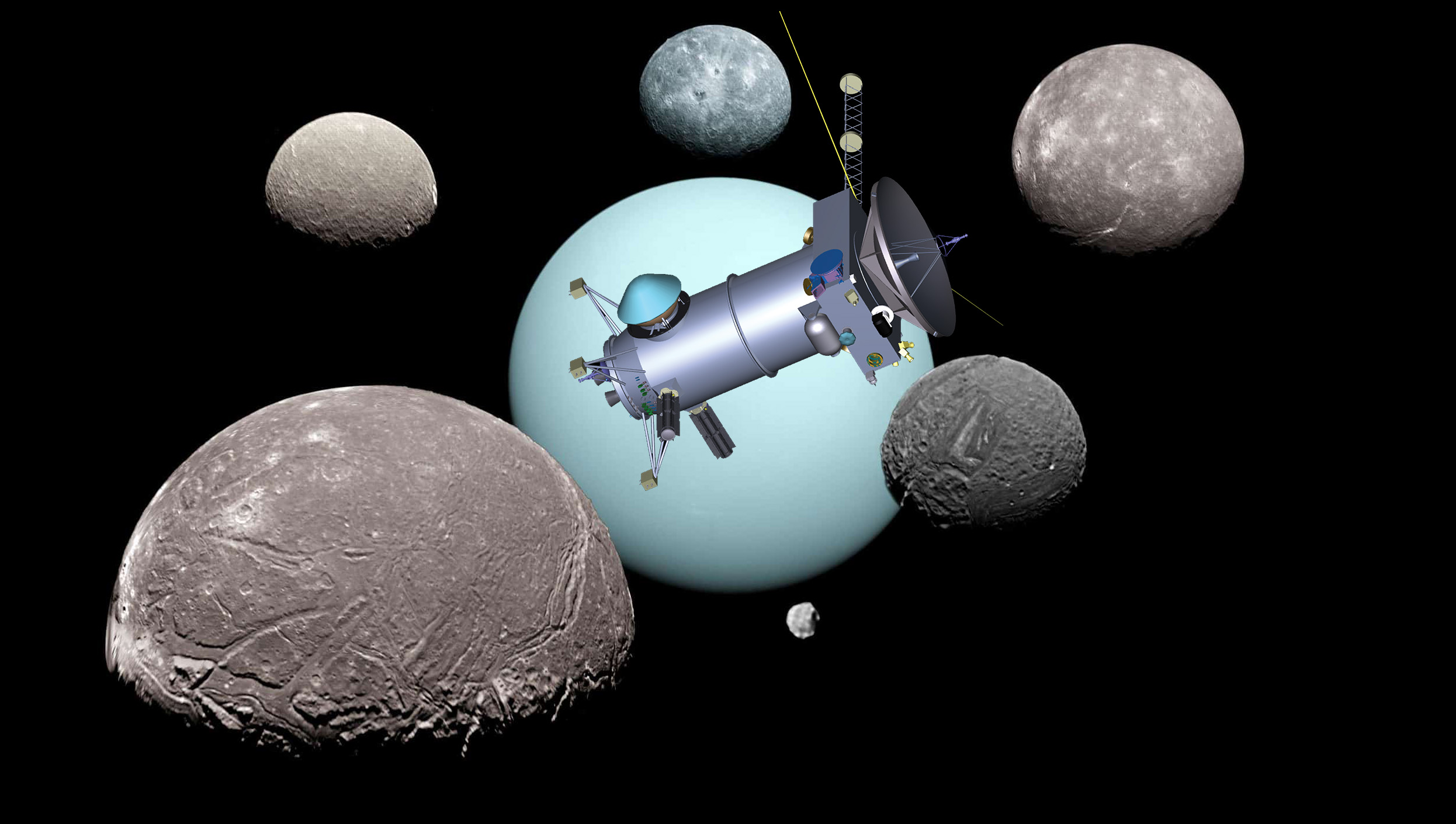

News
SpaceX-launched Uranus mission a top priority of new decadal survey
The National Academies of Sciences, Engineering, and Medicine have published their latest decadal survey of planetary science and astrobiology, revealing a recommendation that NASA prioritize the development of a flagship mission to Uranus baselined to launch on SpaceX’s Falcon Heavy rocket.
Known as the Uranus Orbiter and Probe or UOP, the mission proposal has been under development by a team of NASA, University of California, and Johns Hopkins University scientists and engineers for several years. In fact, a very similar concept ranked third in the Academies’ 2013-2022 decadal survey flagship recommendations, reiterating its central importance and potential value in the eyes of the survey’s dozens of contributors. According to its creators, in its latest iteration, the Uranus Orbiter and Probe have the potential to fully or partially answer 11 of the 12 primary questions the latest Decadal Survey structured itself around.
Additionally, the survey indirectly states that if it weren’t for the existence of one specific technology, it would have been a wash between a mission to Uranus or Neptune. That keystone: SpaceX’s Falcon Heavy rocket.
While the survey’s authors don’t explicitly point to SpaceX in the context of UOP, they do state that “a Uranus mission is favored because an end-to-end mission concept exists that can be implemented in the 2023-2032 decade on currently available launch vehicles.” In reality, there only appears to be one launch vehicle: Falcon Heavy. Three other alternatives do technically exist: United Launch Alliance’s (ULA) Vulcan Centaur, Blue Origin’s New Glenn, and NASA’s own Space Launch System (SLS).
NASA’s Europa Clipper orbiter – originally manifested on SLS but later moved to SpaceX’s Falcon Heavy to avoid major launch delays – has helped demonstrate that SLS isn’t viable for non-Artemis Program missions without massive production improvements and significant workarounds or design changes. While capable in many regards, Blue Origin’s reusable New Glenn rocket appears to have extremely poor performance beyond Earth orbit – well below what UOP requires – and is unlikely to launch before 2024 or 2025. It’s possible that an expendable New Glenn could suffice but Blue Origin has never mentioned the option and, even then, the rocket’s expendable performance could still fall short.
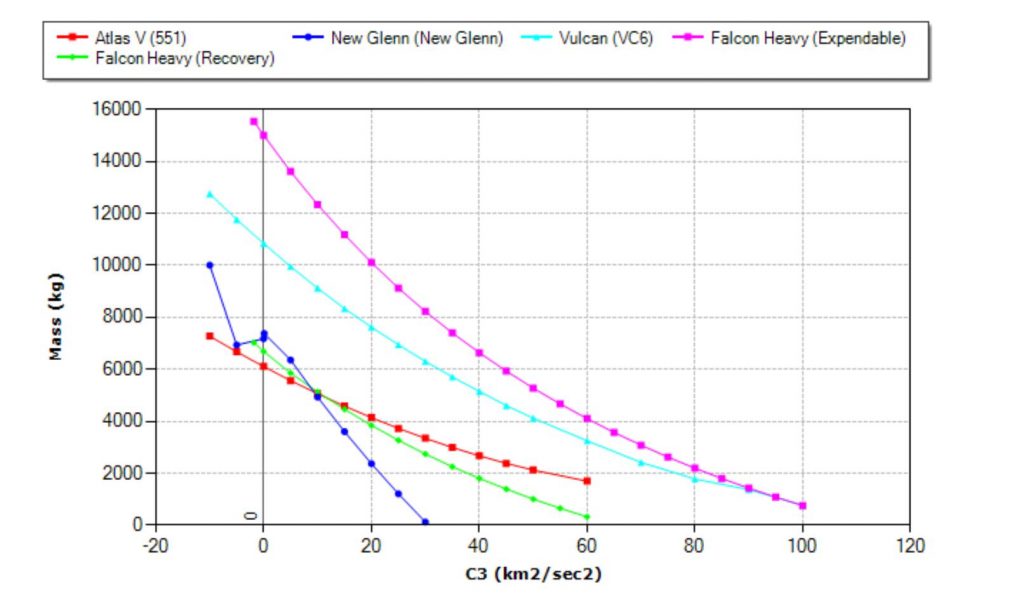
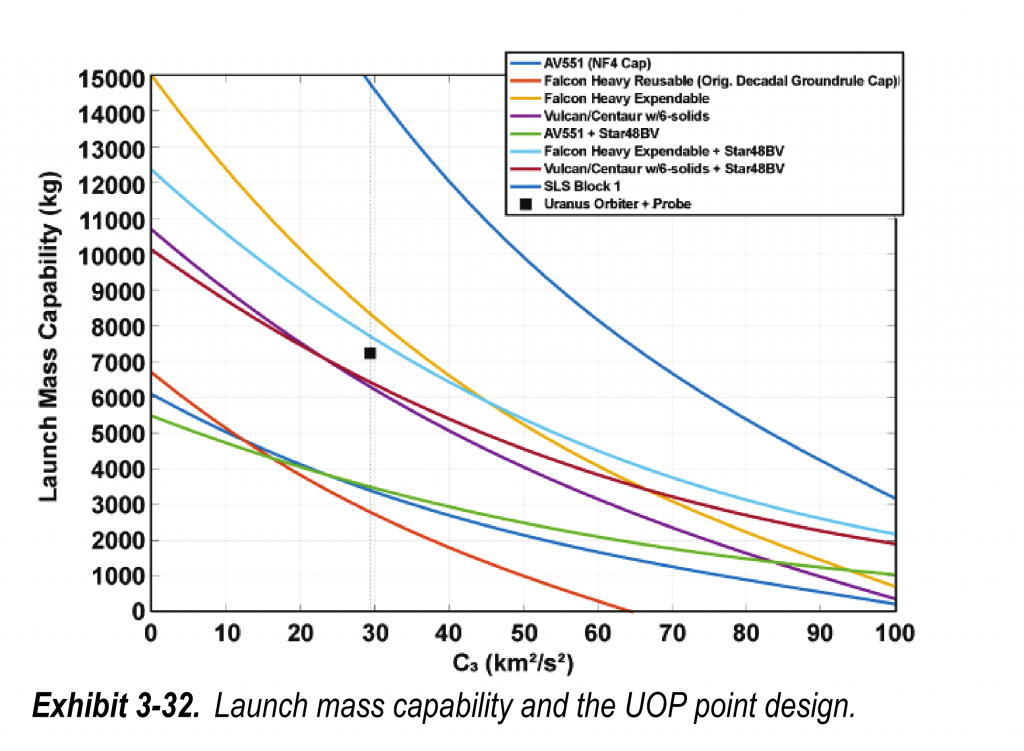
Finally, ULA’s expendable Vulcan Centaur rocket has yet to launch and its debut could easily slip into 2023. More importantly, according to official information provided by the company to a NASA-run performance calculator, even Vulcan’s most capable variant (VC6) with six solid rocket boosters (SRBs) simply doesn’t have the performance required to launch the Uranus Orbiter and Probe (7235 kg / 15,950 lb) on seven of the mission’s preferred trajectories. For three other secondary windows, Vulcan could potentially launch UOP but only with the inclusion of a Venus gravity assist that would require significant design changes to protect the spacecraft while traveling much closer to the sun.
According to NASA’s calculator, a fully-expendable Falcon Heavy rocket with a standard payload fairing could launch around 8.5-10 tons (18,700-22,000 lb) to UOP’s preferred trajectories, leaving a very healthy margin for spacecraft weight gain or launch underperformance and likely enabling a longer launch window for each opportunity.
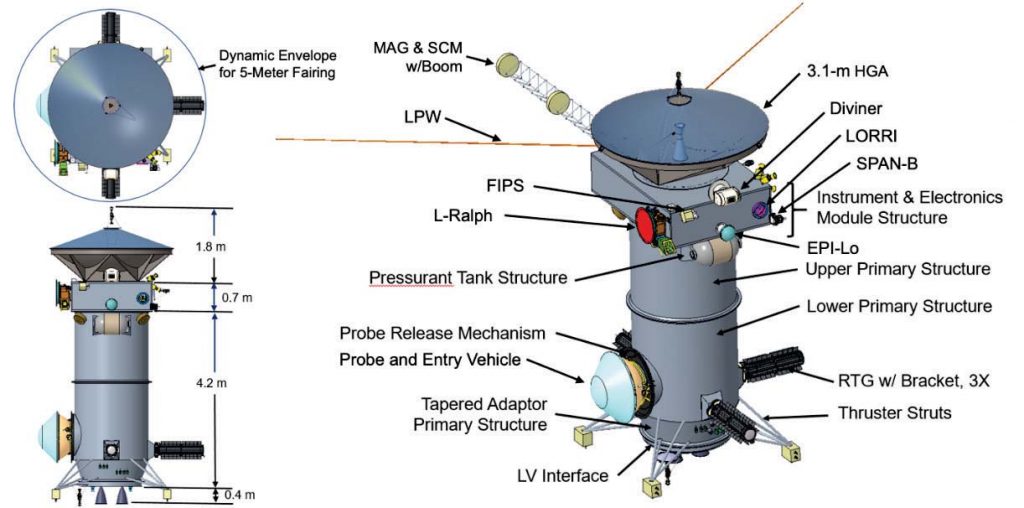
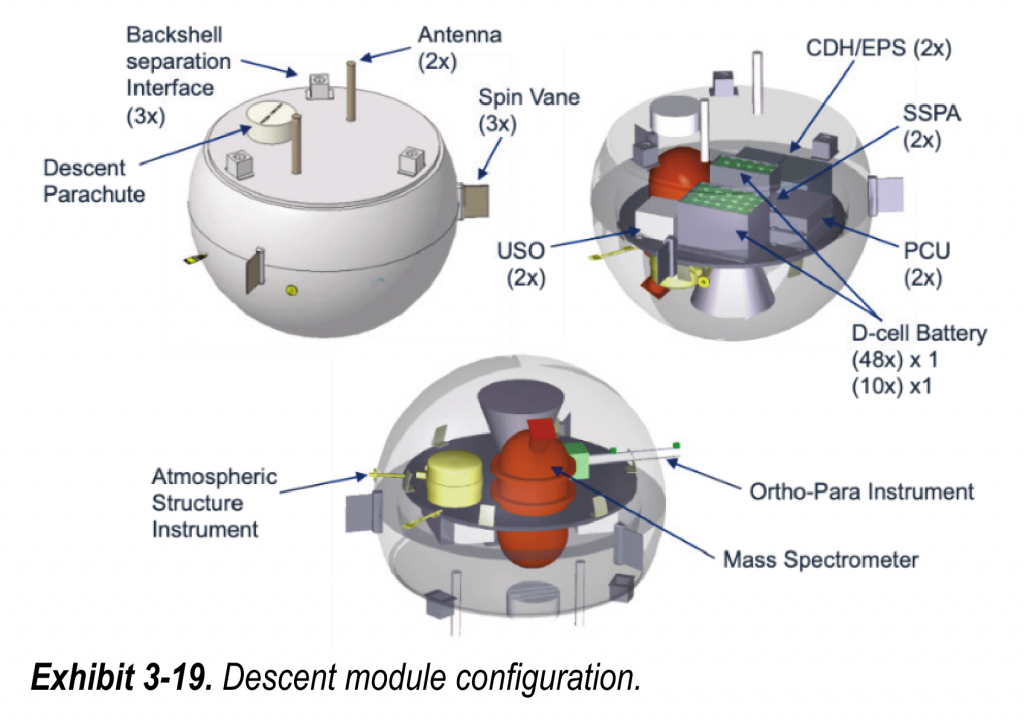
If NASA agrees with the survey’s conclusions, decides to develop the Uranus Orbiter and Probe, and also plans on the Academies’ optimistic assumption of an ~18% budget increase on average from 2023 to 2032, work towards a preferred 2031 launch window could begin in earnest as early as 2024. Comprised of a namesake Orbiter and Probe, UOP would arrive in orbit around Uranus in late 2044 or early 2045 weighing around five metric tons (~11,000 lb). The primary science mission would begin by deploying a small atmospheric probe to directly analyze the composition and behavior of the planet’s exotic atmosphere, which is believed to be volatile, prone to vast and violent storms, and host to some of the most extreme winds in the solar system. The probe would weigh ~270 kilograms (~600 lb) and is only expected to survive for a few hours at most.
The orbiter, however, would continue on to tour the Uranian system for at least four years, observing and studying the ice giant and its rings, magnetosphere, and 27+ moons. Uranus itself resides in what may be the most common class of exoplanets in the universe, making a close study of it invaluable for exoplanet science as a whole. It’s also possible that – like several moons around Saturn and Jupiter – one or more Uranian moons have liquid water oceans created by tidal heating, adding to the list of extraterrestrial bodies that might feature habitable environments or alien life.
News
Tesla begins Robotaxi certification push in Arizona: report
Tesla seems serious about expanding its Robotaxi service to several states in the coming months.

Tesla has initiated discussions with Arizona transportation regulators to certify its driverless Robotaxi service in the state, as per a recent report from Bloomberg News. The move follows Tesla’s launch of its Robotaxi pilot program in Austin, Texas, as well as CEO Elon Musk’s recent comments about the service’s expansion in the Bay Area.
The Arizona Department of Transportation confirmed to Bloomberg that Tesla has reached out to begin the certification process for autonomous ride-sharing operations in the state. While details remain limited, the outreach suggests that Tesla is serious about expanding its driverless Robotaxi service to several territories in the coming months.
The Arizona development comes as Tesla prepares to expand its service area in Austin this weekend, as per CEO Elon Musk in a post on X. Musk also stated that Tesla is targeting the San Francisco Bay Area as its next major market, with a potential launch “in a month or two,” pending regulatory approvals.
Tesla first launched its autonomous ride-hailing program on June 22 in Austin with a small fleet of Model Y vehicles, accompanied by a Tesla employee in the passenger seat to monitor safety. While still classified as a test, Musk has said the program will expand to about 1,000 vehicles in the coming months. Tesla will later upgrade its Robotaxi fleet with the Cyercab, a two-seater that is designed without a steering wheel.
Sightings of Cybercab castings around the Giga Texas complex suggests that Tesla may be ramping the initial trial production of the self-driving two-seater. Tesla, for its part, has noted in the past that volume production of the Cybercab is expected to start sometime next year.
In California, Tesla has already applied for a transportation charter-party carrier permit from the state’s Public Utilities Commission. The company is reportedly taking a phased approach to operating in California, with the Robotaxi service starting with pre-arranged rides for employees in vehicles with safety drivers.
News
Tesla sets November 6 date for 2025 Annual Shareholder Meeting
The automaker announced the date on Thursday in a Form 8-K.

Tesla has scheduled its 2025 annual shareholder meeting for November 6, addressing investor concerns that the company was nearing a legal deadline to hold the event.
The automaker announced the date on Thursday in a Form 8-K submitted to the United States Securities and Exchange Commission (SEC). The company also listed a new proposal submission deadline of July 31 for items to be included in the proxy statement.
Tesla’s announcement followed calls from a group of 27 shareholders, including the leaders of large public pension funds, which urged Tesla’s board to formally set the meeting date, as noted in a report from The Wall Street Journal.
The group noted that under Texas law, where Tesla is now incorporated, companies must hold annual meetings within 13 months of the last one if requested by shareholders. Tesla’s previous annual shareholder meeting was held on June 13, 2024, which placed the July 13 deadline in focus.
Tesla originally stated in its 2024 annual report that it would file its proxy statement by the end of April. However, an amended filing on April 30 indicated that the Board of Directors had not yet finalized a meeting date, at least at the time.
The April filing also confirmed that Tesla’s board had formed a special committee to evaluate certain matters related to CEO Elon Musk’s compensation plan. Musk’s CEO performance award remains at the center of a lengthy legal dispute in Delaware, Tesla’s former state of incorporation.
Due to the aftermath of Musk’s legal dispute about his compensation plan in Delaware, he has not been paid for his work at Tesla for several years. Musk, for his part, has noted that he is more concerned about his voting stake in Tesla than his actual salary.
At last year’s annual meeting, TSLA shareholders voted to reapprove Elon Musk’s compensation plan and ratified Tesla’s decision to relocate its legal domicile from Delaware to Texas.
Elon Musk
Grok coming to Tesla vehicles next week “at the latest:” Elon Musk
Grok’s rollout to Tesla vehicles is expected to begin next week at the latest.

Elon Musk announced on Thursday that Grok, the large language model developed by his startup xAI, will soon be available in Tesla vehicles. Grok’s rollout to Tesla vehicles is expected to begin next week at the latest, further deepening the ties between the two Elon Musk-led companies.
Tesla–xAI synergy
Musk confirmed the news on X shortly after livestreaming the release of Grok 4, xAI’s latest large language model. “Grok is coming to Tesla vehicles very soon. Next week at the latest,” Musk wrote in a post on social media platform X.
During the livestream, Musk and several members of the xAI team highlighted several upgrades to Grok 4’s voice capabilities and performance metrics, positioning the LLM as competitive with top-tier models from OpenAI and Google.
The in-vehicle integration of Grok marks a new chapter in Tesla’s AI development. While Tesla has long relied on in-house systems for autonomous driving and energy optimization, Grok’s integration would introduce conversational AI directly into its vehicles’ user experience. This integration could potentially improve customer interaction inside Tesla vehicles.
xAI and Tesla’s collaborative footprint
Grok’s upcoming rollout to Tesla vehicles adds to a growing business relationship between Tesla and xAI. Earlier this year, Tesla disclosed that it generated $198.3 million in revenue from commercial, consulting, and support agreements with xAI, as noted in a report from Bloomberg News. A large portion of that amount, however, came from the sale of Megapack energy storage systems to the artificial intelligence startup.
In July 2023, Musk polled X users about whether Tesla should invest $5 billion in xAI. While no formal investment has been made so far, 68% of poll participants voted yes, and Musk has since stated that the idea would be discussed with Tesla’s board.
-

 Elon Musk1 week ago
Elon Musk1 week agoTesla investors will be shocked by Jim Cramer’s latest assessment
-

 Elon Musk3 days ago
Elon Musk3 days agoElon Musk confirms Grok 4 launch on July 9 with livestream event
-

 Elon Musk16 hours ago
Elon Musk16 hours agoxAI launches Grok 4 with new $300/month SuperGrok Heavy subscription
-

 News7 days ago
News7 days agoTesla Model 3 ranks as the safest new car in Europe for 2025, per Euro NCAP tests
-

 Elon Musk2 weeks ago
Elon Musk2 weeks agoA Tesla just delivered itself to a customer autonomously, Elon Musk confirms
-

 Elon Musk1 week ago
Elon Musk1 week agoxAI’s Memphis data center receives air permit despite community criticism
-

 Elon Musk2 weeks ago
Elon Musk2 weeks agoTesla’s Omead Afshar, known as Elon Musk’s right-hand man, leaves company: reports
-

 News2 weeks ago
News2 weeks agoXiaomi CEO congratulates Tesla on first FSD delivery: “We have to continue learning!”

















